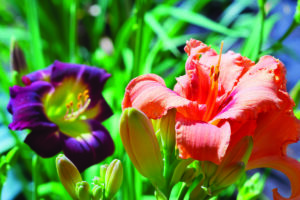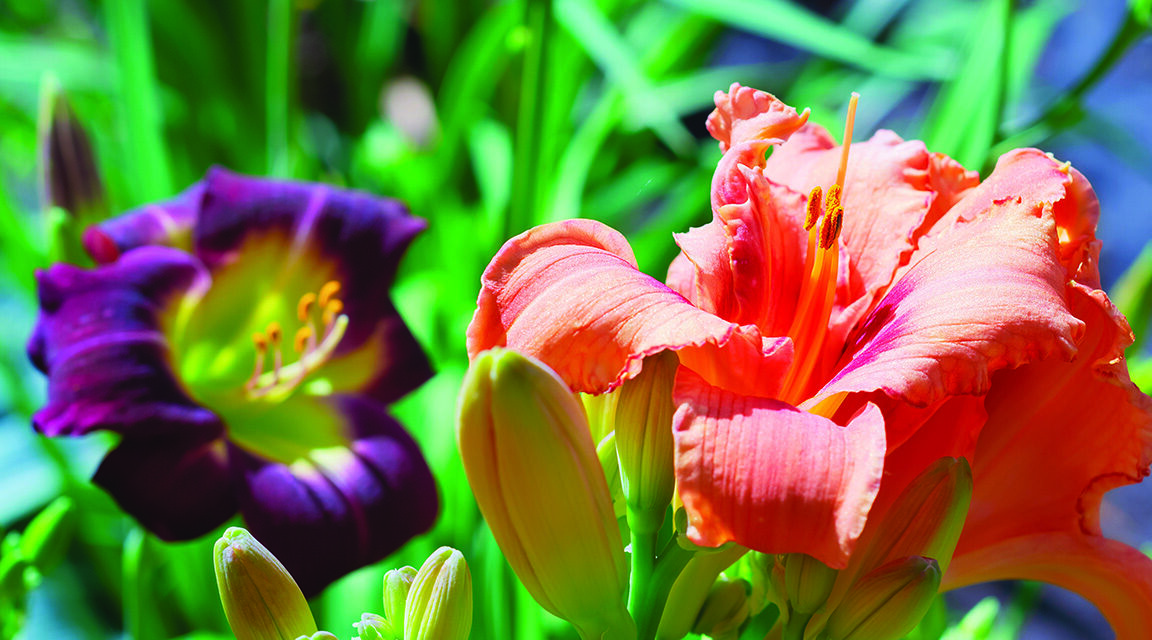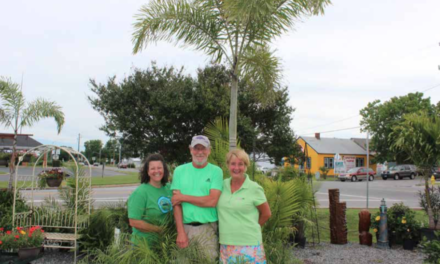
The daylily world now has well over 80,000 cultivars thanks to hybrids offering a huge variety of shapes and colors.
Daylilies got their latin name, Hemerocallis, from greek terms for “beauty” and “day.” They surely are beautiful but don’t let that “day” part throw you off!
They are easy to grow and while a bloom might not last long, the plants produce plentiful blooms to add color to your yard and garden. The biggest challenge in growing daylilies is choosing what that color will be!
Before getting too far into daylilies, the first thing to note is they are different from lilies.
Daylilies are typically shorter and with more foliage at the base than lily Lilium varieties are tall and the flowers all grow at the top. “True lilies” include popular Easter lilies or pink striped “Stargazers.”
The first daylily variety folks are bound to have seen most frequently is one of the originals. The common orange blooms are often referred to as “ditch lilies,” as they come, stay and spread along roadsides. In fact, flower folklore says that settlers had them in the backs of their wagons and they were able to survive the long trips across the country! While their taller height can make them mistaken for a true lily, they are in fact, daylilies.
They also mistakenly get called “tiger lilies” often, but a true tiger lily will be taller and have telltale black spots.
While “ditch lilies” surely aren’t a fancy designer color, they do add natural beauty and interest to a landscape as well as help with erosion control.
Beyond that common variety, the daylily world now has well over 80,000 cultivars thanks to hybrids offering a huge variety of shapes and colors.
So what makes up the 79,999 varieties that aren’t “ditch lilies?”
From color, size, and foliage, the American Hemerocallis Society has come up with quite a few breakdowns for daylily lovers to classify their favorites.
The spectrum of shades is plentiful, with yellows starting a pale lemons to vibrant sunny yellows and deep golds.
Pink to red to deep wine colors, lavenders to deep purple, there’s about as many flower colors as there are paint colors. Day lilies are also one of the few flowers to have shades of true- blue in its spectrums.
Beyond the overall flower color, the American Hemerocallis Society has classified the color categories like “self,” where the flower is entirely monochrome to bitone and reverse bitone where the flower is the same color but different shade and to further define as inward or outward.
Thanks to doubling the chromosomes, daylillies can also be bicolor and beyond.
Also unique to daylilies, there are also classifications for dusting and dotting to include diamond dusting.
These flowers have extra depth where they appear to be dusted with iridescent shimmer in golds, silvers and diamond tones.
These would be such a sweet addition to add a little “fairy magic” if you have little ones with big imagination visiting your garden!
Blooms are further classified into 10 categories by their respective shape: Circular, Triangular, Star, Informal, Ruffled, Flat, Recurved, Trumpet, Spider, and Double.
Another subset is based on the staying power of the foliage. They can be dormant, semi-evergreen, and evergreen, but the latter one graces us in Maryland.
As the hybrids are developed, added features like reblooming have also been created to put on a color show both in the spring and the fall.
The most popular of these is the cheery, bright yellow “Stella d’ Oro,” often a favorite amongst landscapers.
When shopping some of the popular daylily sites, you’ll note many subdivide into the above categories but also into height ranges, date ranges cultivars were created, bloom time and size and more.
They are also usually sold by fan bundles or clumps.
With so many varieties, there are plenty of options for the perfect garden fit!
If you decide to really go down the daylily rabbit hole, yes, there are in fact daylily auctions where true enthusiasts bid on some of the harder to find rare varieties for several hundred dollars!
Regardless if you grab a few cheap fans on a whim or if you decide to splurge on one of the cult favorites, the good news is daylilies are fairly easy to get growing and keep them that way.
Most important is setting them up with a good spot.
A spot in the full sun is preferable but you can still have success in a spot that gets a few hours of shade as well. Soil that drains well is next on the list.
As these perennials come back year after year, allow them some spreading space though eventually you’ll still need to split them.
Are you an avid hummingbird-er? Plant some around your feeders to attract some winged friends and the blooms will also serve as a food source.
Strangely, while people can use them as an ornamental and edible garnish, they’ll make a cat sick so keep in mind if your cat is a nibbler.
After you’ve enjoyed a bloom and it begins to wilt, do take the time to pinch them off to entice another bloom to come along.
If you find yourself hooked or are already a big “fan” of daylilies, check out the American Hemerocallis Society, specifically Region 3, which encompasses Pennsylvania, Virginia, West Virginia, New Jersey, Delaware, and Maryland.
Their big summer regional will take place this year in Chesapeake and Virginia beach.
More details can be found at http://ahsregion3.org.
There are also display gardens to check out, which would be fun to explore on weekend and summer travels.
Daylilies can serve as a fun flower to add into your garden, and go far past the “ditch lily!”
Finding your favorite shade is likely to be more time intensive than the actual upkeep of these unique beauties!






